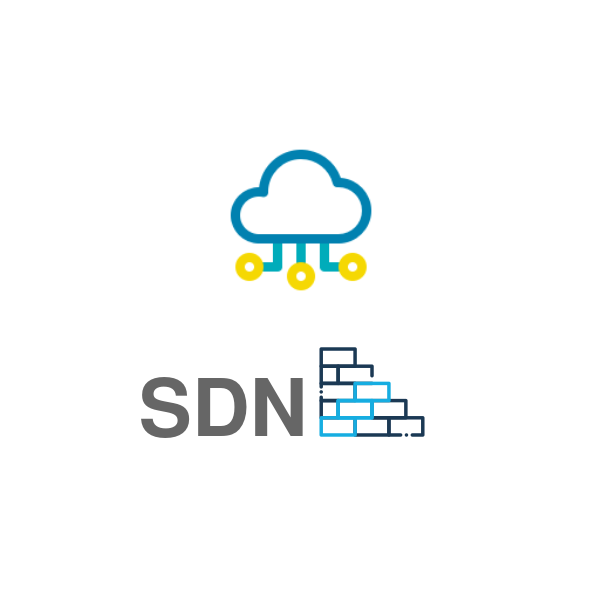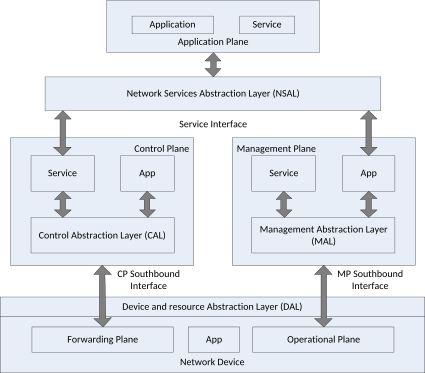General architecture for Software Defined Networking (SDN)

The terminology and layered architecture for SDN systems has been defined by the Software Defined Networking Research Group (SDNRG) of the Internet Research Task Force (IRTF) in [1]. Although it is not intended to standardize any layer or interface, it provides a reference for approaches that can be followed when defining SDN architectures. The Open Networking Foundation (ONF) proposed a different architecture in [2], more service-oriented, while the one proposed by the IRTF has a more functional vision [3].
Figure #1 describes the proposed IRTF architecture which consisting of:
- Application Plane: this layer is where the applications that define the behavior of the network reside.
- Network Services Abstraction Layer (NSAL): provides access to applications to the control and management plane.
- Control Plane: is responsible for decisions on how packets should be forwarded by one or more network devices and for forwarding those decisions to the network devices for execution.
- Management Plane: this layer is in charge of monitoring, configuring and maintaining network devices, e.g., generating decisions based on the state of a network device.
- Device and resource Abstraction Layer (DAL): abstracts resources from the operational and device forwarding planes to the control and management planes.

Following a SDN approach, some examples of proposed architectures can be found in the literature: in [4], the EmPOWER architecture was presented which integrates different Radio Access Technologies (RAT) and proposes a set of programming abstractions in order to model some important aspects of wireless networks. This architecture was also used in [5], where an algorithm for mobility management was proposed; the objective of the algorithm is the adaptation rate for multicast communications in 802.11 networks. Another architecture was presented in [6], which is aimed at minimizing packet-level delay; in this case, all base stations (BSs) are configured to use the same MAC address; specific virtual BSs are created to manage each service. All these proposals include a central controller in charge of network management.
References
- E.Haleplidis, K. Pentikousis, S. Denazis, J.H. Salim, D. Meyer, O. Koufopavlou, (2015). Software-defined networking (SDN): Layers and architecture terminology (No. RFC 7426).
- Open Networking Foundation, “SDN architecture,” vol. 1.0, Jun 2014. https://www.opennetworking.org/ images/stories/downloads/sdn-resources/technical-reports/TRSDN ARCH_1.0_06062014.pdf
- J. Schultz, R. Szczepanski, K. Haensge, M. Maruschke, N. Bayer and H. Einsiedler, “OpenGUFI: An Extensible Graphical User Flow Interface for an SDN-Enabled Wireless Testbed,” 2015 IEEE International Conference on Computer and Information Technology; Ubiquitous Computing and Communications; Dependable, Autonomic and Secure Computing; Pervasive Intelligence and Computing, Liverpool, 2015, pp. 770-776.
- R. Riggio, M. K. Marina, J. Schulz-Zander, S. Kuklinski, and T. Rasheed, “Programming abstractions for software-defined wireless networks,” IEEE Transactions on Network and Service Management, vol. 12, no. 2, pp. 146–162, 2015.
- E. Coronado, R. Riggio, J. Villalón and A. Garrido, “Joint Mobility Management and Multicast Rate Adaptation in Software–Defined Enterprise WLANs,” in IEEE Transactions on Network and Service Management. In press. doi: 10.1109/TNSM.2018.2798296
- K. Nakauchi and Y. Shoji, “WiFi Network Virtualization to Control the Connectivity of a Target Service,” IEEE Transactions on Network and Service Management, vol. 12, no. 2, pp. 308–319, 2015.
Enjoy Reading This Article?
Here are some more articles you might like to read next: